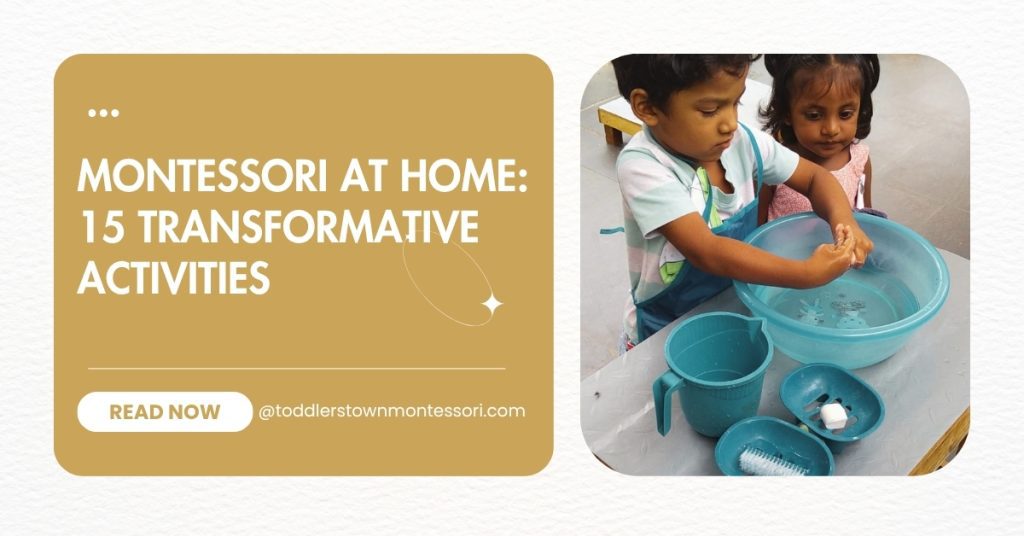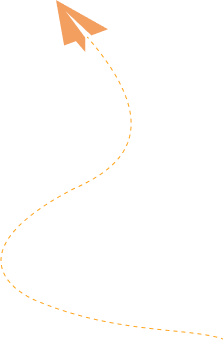- Written by: Nathaliya Perera
- July 23, 2025
- Categories: Parenting Tips
- Tags: , AMI, child-centered education, Montessori home environment, Montessori Method, Montessori toddler activities, Practical life activities toddlers

Transform your living space into a nurturing Montessori environment with these simple, engaging activities designed for curious toddlers.
As parents, we all want to provide our children with the best possible learning experiences. The beauty of Montessori education lies in its ability to foster independence, curiosity, and natural development through hands-on exploration. The wonderful news? You don’t need expensive materials or a formal classroom to bring Montessori activities at home to life.
Dr. Maria Montessori believed that children learn best through purposeful play and real-life experiences. These Montessori toddler activities are specifically designed for children aged 18 months to 3 years, supporting their natural development during this crucial period of rapid growth and learning.
Why Montessori Activities Work So Well for Toddlers
Toddlers between 18 months and 3 years are in what Montessori educators call the “sensitive period” for order, movement, and language development. During this time, children naturally crave:
– Independence and autonomy – They want to do things themselves
– Purposeful activities – Simple tasks that mirror real life
– Order and routine – Predictable environments that build security
– Sensory exploration – Learning through touch, sight, and movement
These DIY Montessori activities tap into these natural developmental needs while using materials you likely already have at home.
Setting Up Your Home Montessori Environment
Before diving into specific activities, create a prepared environment that supports your toddler’s independence:
Accessibility is Key: Place materials at your child’s eye level on low shelves or in accessible baskets. This allows them to choose their own activities and clean up independently.
Natural Materials: Whenever possible, choose wooden, metal, or fabric materials over plastic. Natural materials provide richer sensory experiences and connect children to the real world.
Order and Beauty: Arrange activities attractively in baskets or on trays. This teaches children to care for their environment and appreciate beauty in everyday tasks.
15 Easy Montessori Activities for Toddlers
Practical Life Activities (Ages 18 months - 3 years)
1. Water Pouring Station
Set up a small pitcher, funnel, and two containers on a tray. Fill one container with water and let your toddler practice pouring from one to the other. This develops hand-eye coordination, concentration, and practical skills.
Materials needed: Small pitcher, two containers, funnel, towel for spills
2. Food Preparation Helper
Involve your toddler in real kitchen tasks like washing vegetables, stirring ingredients, or arranging snacks on plates. Use child-safe knives for soft foods like bananas.
Materials needed: Child-sized utensils, cutting board, safe foods
3. Folding Washcloths
Start with simple folding tasks using small washcloths or napkins. Demonstrate slowly, then let your child practice. This builds fine motor skills and teaches care of the environment.
Materials needed: Small washcloths or cloth napkins
4. Flower Arranging
Provide your child with small flowers, a child-sized vase, and water. Let them arrange their own beautiful displays. This activity combines practical skills with aesthetic appreciation.
Materials needed: Small flowers, child-sized vase, water, scissors (with supervision)
5. Polishing Objects
Give your child a soft cloth and show them how to polish wooden spoons, mirrors, or metal objects. This satisfies their need for purposeful work while developing fine motor skills.
Materials needed: Soft cloth, wooden or metal objects, natural polish (optional)
Sensory and Fine Motor Activities
6. Texture Baskets
Create baskets filled with different textured materials: smooth stones, rough sandpaper, soft fabric, bumpy pinecones. Let your child explore and compare textures.
Materials needed: Various textured objects, baskets for organization
7. Color Sorting with Natural Objects
Collect shells, stones, or wooden blocks in different colors. Provide sorting containers and let your child group objects by color. This develops visual discrimination and classification skills.
Materials needed: Natural objects in various colors, sorting containers
8. Threading Large Beads
Use large wooden beads and thick string or shoelaces. Start with just a few beads and gradually increase the challenge. This activity strengthens the pincer grasp needed for writing.
Materials needed: Large wooden beads, thick string or shoelaces
9. Playdough Exploration
Provide natural playdough with simple tools like rolling pins, cookie cutters, or wooden stamps. This open-ended activity supports creativity and hand strength.
Materials needed: Natural playdough, simple tools for exploration
10. Sound Bottles
Fill pairs of small containers with different materials (rice, beans, bells) to create matching sound pairs. This develops auditory discrimination and memory skills.
Materials needed: Small containers, various materials for filling
Language and Cognitive Development
11. Object-to-Picture Matching
Create simple cards with pictures of familiar objects and provide the real objects for matching. This builds vocabulary and connects abstract symbols to concrete items.
Materials needed: Pictures of familiar objects, corresponding real objects
12. Simple Puzzles
Choose wooden puzzles with large pieces and realistic images. Start with 3-4 pieces and gradually increase complexity as your child masters each level.
Materials needed: Age-appropriate wooden puzzles
13. Story Baskets
Create themed baskets with objects that relate to favorite books. For example, a farm basket might include toy animals, while reading farm-themed books together.
Materials needed: Small objects related to favorite stories, baskets
Movement and Coordination
14. Walking the Line
Use masking tape to create a simple line on the floor. Show your child how to walk carefully along the line, carrying different objects or moving in various ways.
Materials needed: Masking tape, various objects to carry
15. Transferring Activities
Set up activities where your child transfers objects from one container to another using tools like tongs, tweezers, or spoons. Start with larger objects and progress to smaller ones.
Materials needed: Various containers, transfer tools, objects to transfer
Tips for Success with Montessori Activities for 2 Year Olds
Follow Your Child’s Interests: The most effective Montessori activities for 2 year olds are those that capture their natural curiosity. If your child shows interest in water, focus on water-based activities. If they love sorting, provide plenty of classification opportunities.
Demonstrate Slowly: Show your child how to do each activity step by step, using slow, deliberate movements. This helps them understand the process and builds their ability to concentrate.
Allow Repetition: Don’t be surprised if your toddler wants to repeat the same activity multiple times. Repetition is how young children master skills and build confidence.
Prepare for Independence: Set up activities so your child can access, use, and clean up materials independently. This builds self-confidence and practical life skills.
Rotate Activities: Keep 4-6 activities available at one time, rotating them weekly to maintain interest and provide new challenges.
Creating a Daily Rhythm with Montessori Principles
Incorporating these activities into your daily routine doesn’t require dramatic changes. Consider these natural opportunities:
Morning: Start with practical life activities like setting the table or watering plants
Mid-morning: Focus on fine motor or sensory activities when concentration is high
Afternoon: Include movement activities or outdoor exploration
Evening: Wind down with quiet activities like looking at books or gentle music
Common Questions About DIY Montessori Activities
Q: How long should activities take?
A: Follow your child’s natural attention span. Toddlers may focus for 2-15 minutes, depending on their age and interest level.
Q: What if my child isn’t interested in an activity?
A: Put it away and reintroduce it later. Children’s interests change rapidly during the toddler years.
Q: Do I need to buy special Montessori materials?
A: While authentic Montessori materials are beautiful, many effective activities can be created with household items and natural materials.
Q: How do I know if an activity is too difficult?
A: Watch for signs of frustration. If your child seems overwhelmed, simplify the activity or save it for later.
Building Independence Through Montessori at Home
The ultimate goal of these Montessori activities at home isn’t just entertainment—it’s building capable, confident children who can navigate their world with independence and joy. Each time your toddler successfully completes a pouring activity, sorts objects by color, or helps prepare a snack, they’re building the foundation for future learning and self-confidence.
Remember that the Montessori approach is about following the child’s natural development, not pushing them to achieve milestones ahead of schedule. These activities provide rich opportunities for growth while respecting your toddler’s individual pace and interests.
Ready to Begin Your Home Montessori Journey?
Starting with Montessori toddler activities at home doesn’t require perfection—it requires presence, patience, and a willingness to see the world through your child’s eyes. Begin with one or two activities that appeal to your toddler’s current interests, and gradually build your collection of meaningful, engaging experiences.
The beauty of Montessori education lies in its recognition that children are naturally eager to learn and grow. By providing thoughtfully prepared activities and a supportive environment, you’re giving your toddler the gift of independence, confidence, and a lifelong love of learning.
Your home can become a rich learning environment where every day brings new opportunities for discovery, growth, and joy. These simple activities are just the beginning of your family’s Montessori journey—one that will continue to evolve as your child grows and develops new interests and abilities.
Ready to explore more Montessori approaches for your child? Contact us to learn about our comprehensive Montessori programs and how we can support your family’s learning journey both at home and in our prepared classroom environments.








